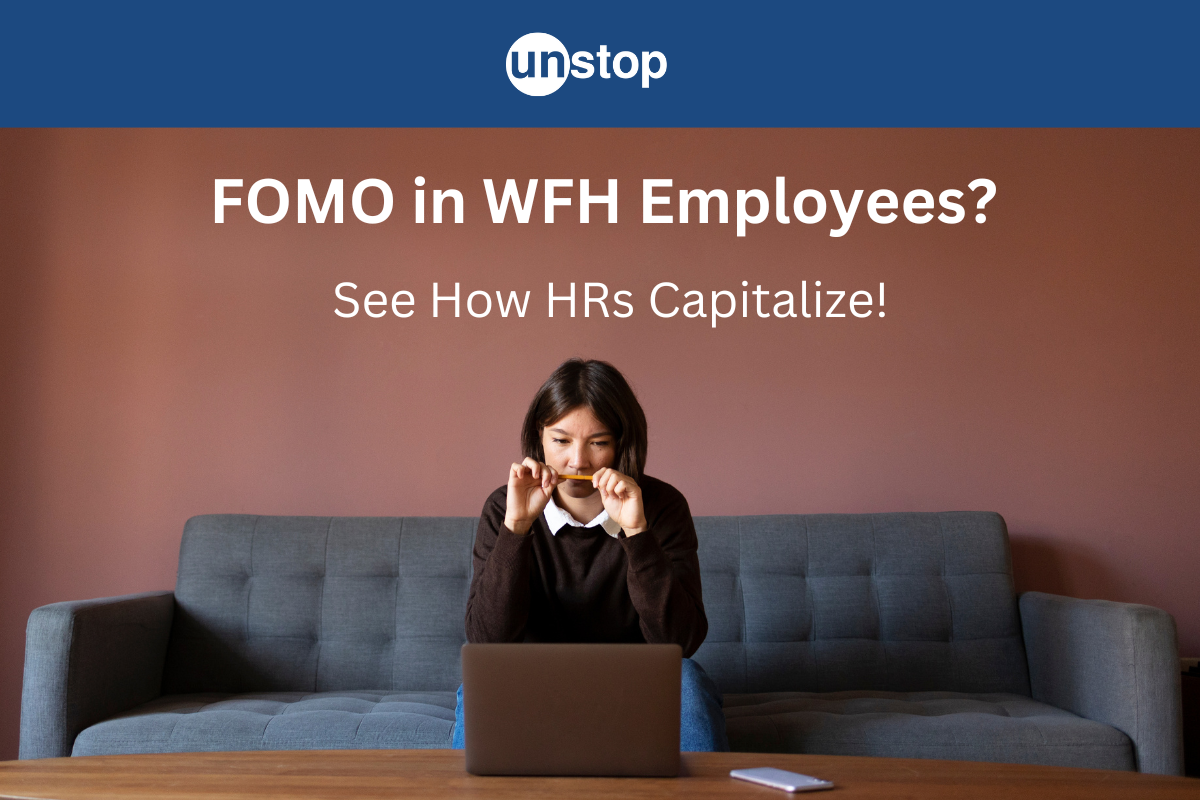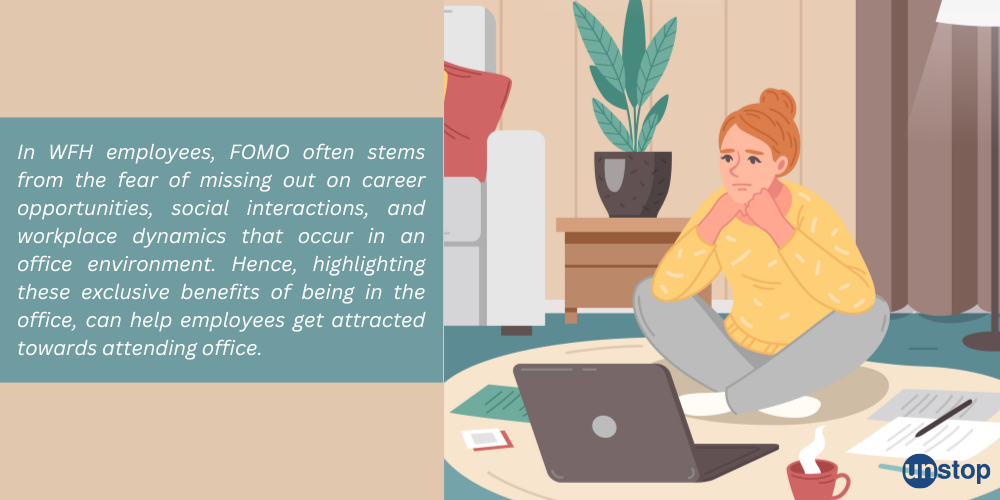- The WFH Dilemma: Why Employees Are Hesitant to Return
- Creating a Healthy Sense of FOMO
- Challenges in Implementation of FOMO Strategy
- Measuring the Impact of FOMO Strategies
- The Path Forward
FOMO - The Critical Ingredient In Return-To-Office Initiatives

The COVID-19 pandemic fundamentally altered the way we work, with remote work becoming the norm for many employees worldwide. However, as companies begin calling employees back to the office, a significant challenge has emerged: many employees are reluctant to return to the traditional office environment. The flexibility, comfort, and convenience of working from home (WFH) have made it difficult for organizations to convince their workforce to rejoin the office setting. However, some companies are finding creative ways to address this challenge by fostering a healthy sense of FOMO (fear of missing out). Let’s explore.
The WFH Dilemma: Why Employees Are Hesitant to Return
Before delving into strategies to create FOMO, it is essential to understand why employees are hesitant to return to the office. Several factors contribute to this reluctance:
- Flexibility and Work-Life Balance: Remote work has provided employees with greater flexibility, allowing them to balance their professional and personal lives more effectively. Commuting time has been eliminated, and many have adapted to a routine that suits their lifestyle.
- Productivity and Comfort: Many employees have found that they are more productive when working from home. The comfort of a personalized workspace, fewer distractions, and the ability to focus have all contributed to this increased productivity.
- Cost Savings: Working from home has resulted in significant cost savings for employees, including reduced expenses for commuting, meals, and work attire.
Given these factors, it is clear that simply mandating a return to the office is unlikely to be effective. Instead, companies need to create compelling reasons for employees to want to come back.

Creating a Healthy Sense of FOMO
As companies consider calling their employees back to the office, the traditional 'carrot and stick' approach—where incentives (carrot) or punishments (stick) are used to motivate employees—proves increasingly ineffective. In the modern workplace, characterized by remote work flexibility and changing employee expectations, a middle path is required.
The 'carrot and stick' method may have worked in the past, but today’s employees seek more than just rewards or the avoidance of penalties. They value autonomy, work-life balance, and meaningful engagement. Offering simple perks or threatening consequences often fails to address these deeper motivations. A more nuanced strategy recognizes these needs and aligns them with organizational goals.
One of the most promising tactics in this middle path approach is capitalizing on FOMO. FOMO, or the fear of missing out, taps into the human desire to be part of something significant and to avoid feeling left out. In the context of returning to the office, FOMO can be a powerful motivator.
Getting FOMO is a powerful psychological phenomenon that can be leveraged to encourage employees to return to the office. By creating an environment where employees feel they are missing out on valuable experiences, opportunities, and connections, companies can motivate them to rejoin the workplace voluntarily. Here are several strategies to achieve this:
1. Curating Exclusive In-Office Experiences
One effective way to create FOMO is by offering unique experiences that can only be accessed in the office. These experiences should be designed to foster a sense of community and belonging while also providing tangible benefits.
Example: A tech company could host weekly "Innovation Fridays" where employees gather in the office to brainstorm new ideas, attend workshops with industry experts, and participate in team-building activities. These events would be exclusive to in-office employees, creating a sense of anticipation and excitement.
2. Enhancing Social Connections
Human beings are inherently social creatures, and the lack of face-to-face interactions during remote work has taken a toll on many employees' sense of connection. Companies can leverage this by creating opportunities for meaningful social interactions that are only possible in the office.
Example: A marketing firm could organize monthly "Lunch and Learn" sessions where employees come together for a catered lunch and listen to guest speakers or engage in group discussions. These sessions would provide both professional development and social bonding opportunities.
3. Offering Career Growth Opportunities
Employees are often motivated by career advancement prospects. By offering exclusive career development opportunities that require in-office presence, companies can create a strong incentive for employees to return.
Example: A financial services company could introduce an "In-Office Leadership Program" where participants receive mentorship from senior executives, attend leadership workshops, and work on high-impact projects. Participation in this program would be contingent on regular office attendance.
4. Showcasing Office Perks and Amenities
Modern office spaces often come equipped with amenities designed to enhance employee well-being and productivity. Highlighting these perks can create a sense of FOMO among remote workers.
Example: A media company could showcase its state-of-the-art gym, wellness rooms, collaborative workspaces, and on-site cafeteria through virtual tours and testimonials from in-office employees. Regular updates on new amenities or improvements would keep remote workers intrigued.
5. Celebrating Milestones and Achievements
Recognizing and celebrating employee achievements is crucial for building a sense of community and belonging. Companies can create special in-office celebrations for milestones and accomplishments.
Example: A software development company could hold quarterly "Achievement Days" where employees are recognized for their contributions through awards ceremonies, team celebrations, and fun activities like game tournaments or themed parties.
6. Encouraging Hybrid Work Models
While some employees may be hesitant to return full-time, offering hybrid work models can provide a balanced approach. By allowing employees to split their time between home and office, companies can make the most of both environments. This flexibility can reduce the resistance to returning to the office while still reaping the benefits of in-person collaboration.
Example: A consulting firm could implement a "3-2 Hybrid Model," where employees are required to be in the office three days a week and have the option to work from home the other two days. This model provides structure while accommodating personal preferences.
Challenges in Implementation of FOMO Strategy
Implementing FOMO (Fear of Missing Out) strategies to encourage work-from-home (WFH) employees to return to the office can present several challenges. Here are some of the key hurdles that organizations might face:
- Resistance to Change: Employees who have adapted to the WFH lifestyle may resist returning to the office. They might have grown accustomed to the flexibility and comfort of working from home, making the transition back to a structured office environment less appealing.
- Perceived Lack of Benefits: If employees do not see a clear and compelling advantage to working from the office, FOMO strategies will fall flat. For example, if the in-office experience does not significantly differ from the remote experience in terms of collaboration or access to resources, employees may not feel motivated to return.
- Health and Safety Concerns: In the post-pandemic era, health and safety remain top priorities for many employees. Concerns about potential exposure to illnesses in a communal office space can deter employees from wanting to return, regardless of any FOMO tactics employed.
- Commuting Issues: The prospect of a long or stressful commute can be a significant deterrent. For instance, employees who have moved further away from the office during the pandemic may find the idea of daily travel particularly unappealing.
- Work-Life Balance: Many employees have found a better work-life balance while working from home. Implementing FOMO strategies that ignore this aspect can backfire. For example, parents who have enjoyed more time with their children might resist returning to an office setup that disrupts this balance.
- Ineffective Communication: Poorly communicated FOMO strategies can lead to misunderstandings and mistrust. If employees feel manipulated or coerced rather than genuinely enticed by the benefits of returning to the office, they are likely to push back.
- Diverse Workforce Needs: A one-size-fits-all approach may not work due to the diverse needs and preferences of the workforce. For instance, younger employees might be more attracted to social events and networking opportunities, while older employees might prioritize different aspects such as quiet workspaces or ergonomic setups.
- Technological Disparities: Some employees might have invested in better home office setups than what is available at the office. If they perceive their home technology as superior, they may resist returning to an environment where they feel less equipped.
- Cultural Shifts: Over time, company culture may have shifted towards remote work norms. Reverting to an in-office culture requires significant effort and buy-in from all levels of the organization, which can be challenging to achieve.
- Inconsistent Implementation: If FOMO strategies are not consistently implemented across all departments or teams, it can lead to feelings of unfairness and resentment among employees. For example, if only certain teams are given incentives or perks for returning to the office, it may create divisions within the organization.
Addressing these challenges requires a thoughtful and empathetic approach that considers the diverse needs and concerns of the workforce while clearly communicating the benefits and support available for returning to the office.
Measuring the Impact of FOMO Strategies
To ensure that these FOMO strategies are effective, it is essential to measure their impact through various metrics. Companies should regularly gather feedback from employees, monitor attendance patterns, and assess overall productivity and engagement levels. This data will help organizations refine their approaches and continue to create compelling reasons for employees to return to the office.
Example: Conducting quarterly employee surveys that focus on satisfaction with in-office experiences, perceived benefits, and suggestions for improvement can provide valuable insights. Additionally, tracking key performance indicators (KPIs) such as project completion rates, collaboration frequency, and employee retention can help evaluate the success of FOMO-driven initiatives.
The Path Forward
In the post-pandemic world, the traditional office environment must evolve to meet the changing needs and expectations of employees. By leveraging the psychology of FOMO, companies can create a dynamic and engaging workplace that employees are excited to be a part of. The key lies in offering unique in-office experiences, fostering social connections, providing career growth opportunities, showcasing office perks, celebrating achievements, and embracing hybrid work models. Through these strategies, organizations can rebuild a sense of community and belonging, ultimately leading to a more motivated and productive workforce.
Suggested Reads:
As a biotechnologist-turned-writer, I love turning complex ideas into meaningful stories that inform and inspire. Outside of writing, I enjoy cooking, reading, and travelling, each giving me fresh perspectives and inspiration for my work.
Login to continue reading
And access exclusive content, personalized recommendations, and career-boosting opportunities.
Subscribe
to our newsletter
Blogs you need to hog!

Organize Hackathons: The Ultimate Playbook With Past Case Studies

What is Campus Recruitment? How To Tap The Untapped Talent?

Lateral Hiring: A Complete Guide To The Process, Its Benefits, Challenges & Best Practices













Comments
Add comment